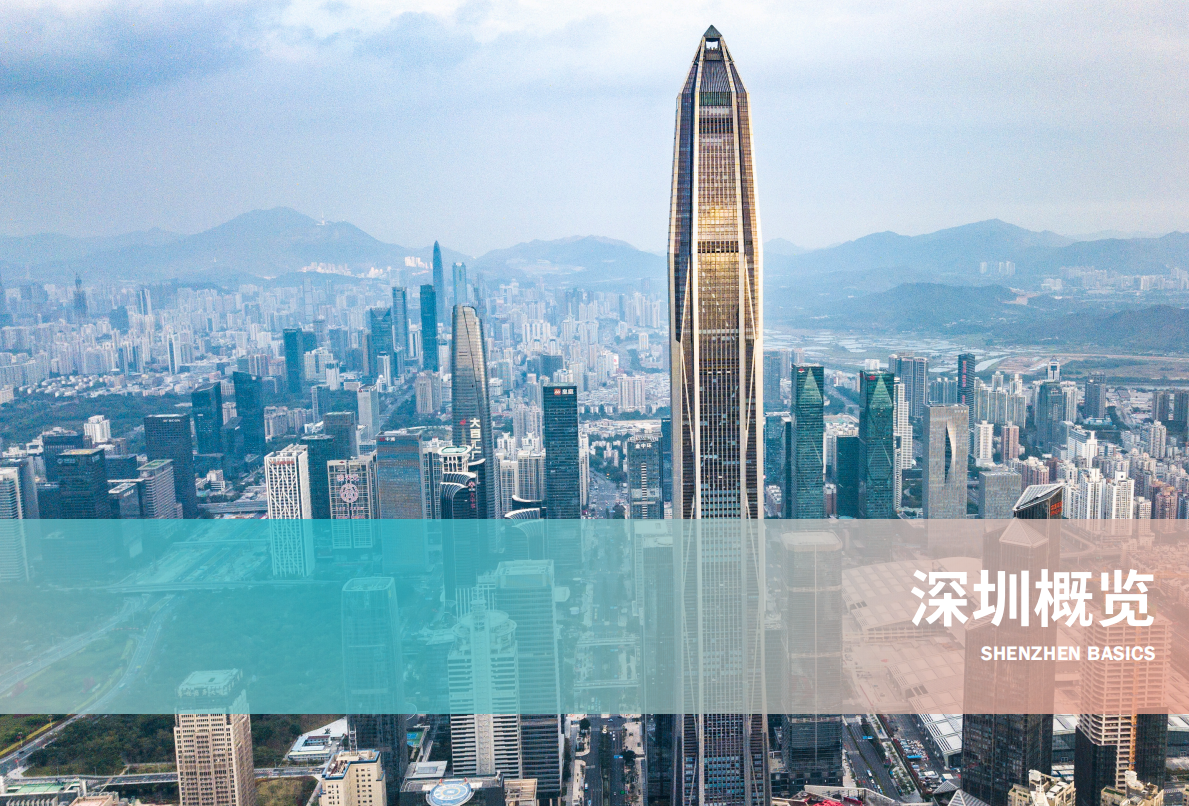Shenzhen Basicis
Time:2021-08-01 15:55:28

Development Goal
Shenzhen has been designated as a national pilot city for comprehensive reform. It is a national economic center, a science and technology innovationcenter, a regional financial center and a commercial and logistics center. It strives to take the lead in creating a moderately prosperous city, pushing forward the construction of the Guangdong-Hong Kong-Macao Greater Bay Area, building a pioneering demonstration zone of socialism with Chinese characteristics, and an exemplar city of a great modern socialist country.
Geographic Location
Shenzhen is a coastal city in South China, adjoining Hong Kong.Its longitude lies between 113.43 and 114.38 degrees east, and its latitude between 22.24 and 22.52 degrees north. Sitting south of the Tropic of Cancer, it is in southern Guangdong Province. Demarcated from Hong Kong by the Shenzhen River in the south, it is bordered by Dongguan and Huizhou in the north, Daya Bay and Dapeng Bay in the east and the Lingding Sea and the mouth of the Pearl River in the west.
Natural Resources
The total area of Shenzhen is 1,997.47 square kilometers. Shenzhenhas 11 hydrographic systems (including Shenshan area) and 362 rivers and streams with more than one square kilometer of drainage area. Shenzhen has a vast sea area of 1,145 square kilometers and boasts 260 kilometers of coastline. The city also has rich natural attractions, including the popular beaches such as Dameisha, Xiaomeisha, Xichong and Judiaosha, and nature reserves like Dapeng Pennisula National Geopark, Mangrove Nature Reserve, Wutong Mountain and Inner Lingding Island.
Climate
Shenzhen has a subtropical monsoon climate. Its weather isgenerally temperate to mild, with plenty of rain and sunshine. The annual average temperature is 23 degrees Celsius. The average annual rainfall totals 1,935.8 millimeters and the average yearly number of hours of sunshine is 1,837.6.
Official Trees and Flower
The litchi and mangrove trees are Shenzhen’s official trees and its official flower is bougainvillea.

History
The earliest-known records bearing the name Shenzhen date from1410, during the Ming Dynasty (1368-1644). Shenzhen became a township at the beginning of the Qing Dynasty (1644-1911). Local people called the drains in paddy fields “zhen” or “chong.” Shenzhen literally means “deep drains” because the area used to be crisscrossed by rivers and streams – and still is, today – with deep drains in the paddy fields. Shenzhen is also known as the “Roc City” because maps of the city’s outline resemble a flying roc with its wings spread. The city of Shenzhen was established in 1979. In August the following year, the country’s first special economic zone was established here. Human activity in the area dates back more than 6,700 years. The area was founded as a county 1,700 years ago and is home to 600-year-old cultural relics such as Nantou Ancient City and Dapeng Fortress. The Hakka people migrated to the area from central China about 300 years ago.
Administrative Divisions
Shenzhen is a sub-provincial city. It has direct jurisdiction over nine districts and one new area:Futian, Luohu, Yantian, Nanshan, Bao’an, Longgang, Longhua, Pingshan and Guangming districts, and Dapeng New Area. The Central Government expanded the special economic zone to cover the whole city on July 1, 2010. Shenshan Special Cooperation Zone was officially inaugurated on Dec. 16, 2018.
Demographics
Shenzhen’s population increased dramatically after the city of Shenzhen was established. By the end of 2020, its permanent resident population reached 12.6855 million. Among the permanent residents, 5.874 million are with Shenzhen hukou, accounting for 46.3 percent of the total permanent resident population, up 18.72 percent from the previous year. A city of migrants, Shenzhen is openminded, tolerant and innovative. It is an ideal place for domestic and international talent to start businesses. It has been voted as China’s Most Dynamic City, City Most Favored by Migrant Workers and City Most Favored by Domestic and Overseas Talent.
Languages
Shenzhen is the only city in Guangdong Province where Mandarin is the dominant language, because of its huge population of migrants from all over China. Many public service employees, professionals and businesspeople speak English too. Most of the young people speak English and Cantonese. The Shenzhen Speaks Foreign Languages campaign is held across the city to encourage more residents and government employees to learn to speak foreign languages.
Economic Status
Located at the forefront of the Pearl River Delta area, Shenzhen has been the link between the Chinese mainland and Hong Kong, and a transport hub for coastal southern China. It takes the lead in hightech development, financial services, foreign trade, shipping, and the creative and cultural industries in China. Shenzhen has undertaken the mission to pilot China’s structural reform and continuous opening up to the outside world. Shenzhen ranks fifth in Asia in terms of economic power. The city’s GDP grew by 3.1 percent to reach 2.77 trillion yuan in 2020. Shenzhen’s public finance reached 942.4 billion yuan, of which local general public budget revenue was 385.7 billion yuan, up 2.2 percent. The total revenue of enterprises above designated scale in the city grew 10.6 percent. More than 3.59 million new businesses were registered in Shenzhe. Some 1.2 million talents were introduced to the city and the number of full-time academicians in Shenzhen has increased to 61. As of June 2021, about 170,000 overseas returnees have settled in the city.

Transportation
Shenzhen has land, sea, air and rail ports. By the end of 2020, there are 76 container berths, with a berthing capacity of 10,000 tons each, in the city, making Shenzhen Port a preferred port for ultra-large container ships in South China. Shenzhen has eight train stations, including Shenzhen Railway Station, Shenzhen North Railway Station and Shenzhen East Railway Station. Shenzhen has become an important national railway hub with the GuangzhouShenzhen-Hong Kong Express Rail Link, an important rail link in the country, passing through and the construction of the Ganshen (Ganzhou-Shenzhen) High-speed Railway under way. One of China’s 10 largest airports, Shenzhen Bao’an International Airport has operated over 60 international air routes. The Shenzhen airport is among the world’s top 100 airports. Shenzhen has 15 checkpoints that facilitate the flow of both Chinese and foreign nationals and cross-border vehicle traffic. Among the 15 checkpoints, Luohu Checkpoint is China’s busiest land passenger checkpoint and Huanggang Checkpoint offers around-theclock border-crossing service. Futian Checkpoint offers seamless transfer by Metro to Hong Kong while Shenzhen Bay Checkpoint offers both Hong Kong and Shenzhen immigration inspection service, the only of its kind in the country. The 144-hour visa-free transit policy for foreign visitors was implemented at the Shenzhen airport in 2019, taking the total international air routes from the Shenzhen airport to 60. The total passenger throughput of the Shenzhen airport reaches 37.91million, including 0.61 million international visitors (not including passengers from Hong Kong, Macao and Taiwan).

Public Security
Shenzhen is one of the safest and fairest cities with the best legal environment in the country. The Shenzhen Municipal Public Security Bureau has pushed forward the application of “new smart police services” and launched the “Shenwei” online platform featuring facial recognition technology to provide one-stop, streamlined and intelligent services. It provides “one window” services to foreign job seekers. In 2020, the bureau put online 157 services and simplified the procedures of 105 other services, with an aim to provide conveniences to local residents and improve public welfare. The Shenzhen public security bureau has been ranked first for three consecutive years in Guangdong Province in terms of public satisfaction.
quote: SHENZHEN DAILY . SHENZHEN TODAY 2021[M] . Shenzhen:Information Office of the Shenzhen Municipal People’s Government ,2021:8-19



 WeChat
WeChat